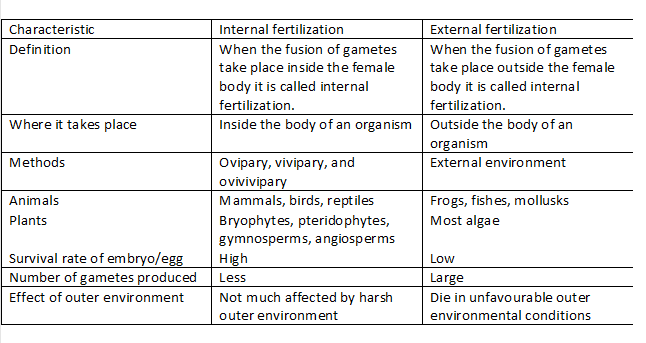Introduction to Reproductive Strategies
Reproduction is crucial for the survival of species, and vertebrates have evolved various strategies to ensure reproductive success in diverse environments. Understanding these strategies not only enhances knowledge of biology but also helps appreciate the adaptations in the animal kingdom.
Key Concepts
- Reproductive Success: The ability to produce viable offspring that can also reproduce.
- Adaptation: Changes in organisms that enhance their survival and reproduction in specific environments.
Types of Reproduction
1. Fertilization Methods
a. External Fertilization
- Definition: Fertilization occurs outside the female's body.
- Process:
- Eggs are released into the water by the female.
- Males release sperm over the eggs simultaneously.
- Example: Most fish and amphibians (e.g., frogs).
- Advantages:
- Large number of gametes can be produced.
- Water protects eggs from drying out and facilitates sperm movement.
- Disadvantages:
- High predation risk for eggs.
- Environmental factors can affect success (e.g., water temperature).
b. Internal Fertilization
- Definition: Sperm fertilizes the egg within the female's reproductive tract.
- Process:
- Males transfer sperm through copulation.
- Example: Most reptiles, birds, and mammals.
- Advantages:
- Greater control over fertilization.
- Protection of embryos from environmental hazards.
- Disadvantages:
- Requires more energy and complex reproductive organs.
2. Developmental Strategies
a. Ovipary
- Definition: Eggs are laid outside the mother, where they develop and hatch.
- Examples: Birds, most reptiles, and some fish.
- Advantages:
- The egg provides nutrients and protection.
- Reduces the burden of carrying developing young.
- Disadvantages:
- Eggs are vulnerable to predation and environmental changes.
b. Vivipary
- Definition: Young develop inside the mother’s body, nourished via a placenta.
- Examples: Most mammals, some reptiles (e.g., certain sharks).
- Advantages:
- Direct nutrient supply increases embryo survival.
- Young are born more developed and ready for life outside.
- Disadvantages:
- Higher metabolic cost for the mother.
- Limited number of offspring produced.
c. Ovovivipary
- Definition: Eggs are fertilized internally and retained in the mother's body until they hatch.
- Examples: Some reptiles and sharks.
- Advantages:
- Embryos are protected from external threats until they hatch.
- Young are born live and often more developed.
- Disadvantages:
- Limited number of offspring compared to oviparous species.
3. Egg Types and Structures
a. Amniote Egg
- Definition: An egg characterized by a shell and extraembryonic membranes.
- Components:
- Yolk Sac: Provides nutrients.
- Allantois: Waste storage and gas exchange.
- Chorion: Facilitates gas exchange.
- Advantages:
- Protects the embryo from dehydration and mechanical damage.
- Enables reproduction in terrestrial environments.
4. Developmental Patterns
a. Precocial Development
- Definition: Offspring are relatively mature and mobile at birth/hatching.
- Examples: Birds like ducks, many ungulates.
- Advantages:
- Greater independence reduces parental investment after birth.
- Better survival rates in the wild.
- Disadvantages:
- Higher energy expenditure for parents during gestation.
b. Altricial Development
- Definition: Offspring are born or hatched in a helpless state.
- Examples: Most songbirds, rodents.
- Advantages:
- Allows for extensive parental care and protection.
- Young can develop more complex brains post-hatching.
- Disadvantages:
- Higher vulnerability to predation before becoming independent.
5. Parental Care
- Definition: Involves behaviors that enhance the survival of offspring.
- Types of Care:
- Nest building, guarding eggs, feeding young, teaching survival skills.
- Advantages:
- Increases offspring survival rates.
- Enhances learning opportunities for young.
Fun Learning Tips
- Visual Aids: Use diagrams to illustrate fertilization types and developmental stages.
- Flashcards: Create flashcards for different terms (e.g., ovipary, vivipary) with definitions and examples.
- Quizzes: Test your knowledge with quizzes on each strategy's advantages and disadvantages.
- Group Study: Discuss these strategies with classmates to reinforce learning through teaching.
- Interactive Activities: Use models or simulations to represent different types of eggs and their structures.
Summary
Vertebrates employ a variety of reproductive strategies to adapt to their environments. From the choice between internal and external fertilization to different developmental patterns, each strategy has evolved to maximize the chances of reproductive success. Understanding these processes enhances our appreciation of biodiversity and the complexities of life.










.jpg)

0 Comments